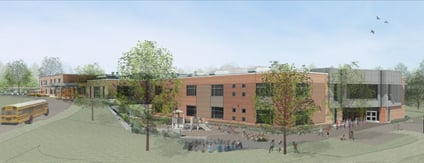From the furniture to the sound systems, the brand-new Nelson Place School is designed to meet the needs of all students, including children with autism.
 When the students and staff at Nelson Place School in Worcester, MA, move into their brand-new, $58 million building next fall, they’ll find a number of innovative features designed to accommodate children with a wide range of challenges and abilities—including those diagnosed on the autism spectrum.
When the students and staff at Nelson Place School in Worcester, MA, move into their brand-new, $58 million building next fall, they’ll find a number of innovative features designed to accommodate children with a wide range of challenges and abilities—including those diagnosed on the autism spectrum.
From the layout of the classrooms and common areas, to the furniture, color schemes, and even the technology systems, the new Nelson Place School is a model for how to build an inclusive elementary school that can serve the needs of all students.
“Virtually every choice we have made in the building’s design was made with inclusion in mind,” said architect Robert Para of Lamoureux Pagano & Associates. “Our goal is to integrate students with special needs into general-education classrooms as best we can.”
One of the features that Principal Monica Poitras is most excited about is a unique classroom audio solution that will help students and teachers hear each other more clearly. The solution is much more than a simple sound amplification system; it involves two-way audio, so teachers can connect with and monitor their students to provide personalized instruction from anywhere in the room.
“I’m very excited about it,” Poitras said. “It’s going to be a huge benefit to all of our students.”
Inclusive Classrooms and Private Hallways
Part of the Worcester Public Schools, Nelson Place School currently serves about 450 students in kindergarten through 6th grade. It’s also the site of a special district program serving children with autism; more than 60 of its students fall somewhere on the spectrum.
The new 112,000-square-foot facility, which is currently under construction, will add three preschool classrooms and will serve about 600 students in all. There are two separate wings, one for the preschool through 2nd-grade classrooms and the other for 3rd through 6th grades. In between are a cafetorium, gym, main office, and nurse’s office.
One of the classrooms at each grade level has been designated as an inclusion classroom for children with autism and other special needs. Adjacent to this room is an observation room with a one-way mirror, so educators—or parents—can observe the children interacting in the classroom environment without being intrusive. “It can be disruptive if someone an autistic child doesn’t know well enters the room,” Poitras explained.
Transitions, such as moving from one classroom to another, can be hard for students with autism as well. To make this process easier, the new school has a short private hallway that connects each inclusion classroom to a general-education classroom, so students don’t have to go out into the main hallway, “where it can be very busy and chaotic sometimes,” Poitras said. There are even separate bathrooms off this private hallway, so children with autism don’t have to go down the hall to use the bathroom.
“It’s like they’re not really leaving the room,” she noted.
Also located next to each inclusion room is what Poitras calls a therapeutic room, equipped with squishy balls, beanbags, and other soothing sensory items. “It’s a safe and quiet space where we can take children when their behavior escalates and they can’t regulate their bodies,” she said. “We can apply strategies to help them [calm down], so they can go back to learning. Right now, we don’t have a space like that—so sometimes we’re out in the hallway with kids, or they’re in my office.”
Standing Desks and Soothing Colors
The school’s furniture was chosen with an eye toward letting students work off excess energy, which will help children who have Attention Deficit Disorder or who struggle to sit still.
All of the classrooms will have regular chairs, but they’ll also have seating designed to meet the needs of kids who are fidgety. These options will include Zenergy Ball Chairs from Safco, which are like exercise balls with metal feet, enabling kids to bounce as they sit; as well as Hokki Stools from Kaplan Early Learning. The Hokki Stools “almost look like a Sit N Spin,” Poitras said, “but they’re taller and they rock in all directions.”
In 3rd through 6th grade, each classroom also will contain a handful of standing-height desks. “When kids are given the opportunity to stand during instruction, they burn more calories and seem to have a greater attention span,” she explained.
The color schemes were carefully chosen as well. Typically, elementary schools feature lots of bright primary colors. The new Nelson Place School will use quieter tones, with each grade level having its own color palette. “We looked at different research suggesting that certain colors can overstimulate kids,” Poitras said. “So we picked very muted colors—such as sand and sage—that won’t have that effect.”
Hearing Clearly and Listening Unobtrusively
To ensure that all students can hear their teacher clearly, the new facility will employ an audio system from Lightspeed Technologies in each classroom.
“It’s like a surround-sound system,” Poitras said. “The teachers will wear a microphone on a lanyard around their necks. When they turn it on, they can speak with a regular voice. We piloted the system here last year, and one of the things the teacher noticed was that she wasn’t as tired at the end of the day, because she didn’t have to strain her voice to be heard.”
Voice amplification can help all students learn better, not just those with hearing problems. Studies suggest they can improve student achievement and lower special-education referral rates, while also leading to better classroom management and fewer teacher sick days as a result of voice strain. Earlier this year, researchers concluded that high levels of ambient noise are more distracting to a child’s brain than an adult’s, hindering how students learn. Lightspeed’s classroom audio system evenly distributes the voice above the ambient noise level so everyone can hear clearly.
What makes Lightspeed’s Flexcat system unique is that it includes two-way speaker “pods” that can be placed strategically inside or outside each classroom. Teachers can project their voice to the entire class, enabling all students to hear more effectively—but they also can listen in as the children work together in small groups. Teachers can monitor this group work from a distance, giving children the opportunity to feel independent and the teacher an authentic view of the students’ capabilities and interactions within the group. Students can always contact the teacher with the press of a call button.
“If I see that a group is not doing the assignment they’re supposed to be doing, I can press the remote button and talk into my microphone—and only that group can hear me,” Poitras said. “The teacher doesn’t have to yell across the room,” distracting other students, or leave one group to support another. “It’s a nicer way of paying attention to small groups and individual students.”
Poitras is excited about the system’s potential to help all students learn, and her enthusiasm stems from a very personal connection. “My own son is 13, and he was diagnosed with an auditory processing issue,” she explained. “We’ve been trying to get him to wear an FM auditory system, and at 13, he wants no part of it. His new school actually has the same classroom audio system, and it’s been working well for him. He can hear what the teacher is saying now, and he doesn’t have to wear this awkward device.”
School leaders requested the Flexcat system as part of the new school’s technology specifications, said Azim Rawji, principal at ART Engineering, which wrote the specs. Another innovative technology feature is that teachers will be able to control the volume of the public address system in their classroom from a computer or handheld device. “Children with autism can get nervous when they hear a schoolwide announcement,” Rawji said.
A High-Tech Collaboration
Each classroom at Nelson Place will also have a whiteboard and interactive projector, and there are emergency stations throughout the building where staff members can press a button and call for help without picking up a telephone handset. WiFi will be available throughout the facility, and there will be carts with iPads or laptops for every grade level.
The building itself will be LEED-certified, with solar panels allowing it to produce at least three-quarters of its own electricity.
The design process was collaborative, with department heads and teachers having input on what they wanted. In keeping with the theme of inclusion, even students got involved in choosing the new school’s furnishings. “I had vendors send us samples of their furniture, so we could physically look at it,” Poitras said. “We had it staged in the library, and the kids would try it out.”
Dennis Pierce is a freelance writer who has been covering education for nearly 20 years. Follow him on Twitter: @denniswpierce.


